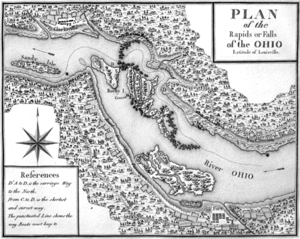Corn Island (Kentucky) facts for kids
Corn Island, once known as Dunmore's Island, was an island in the Ohio River. It was located near the Falls of the Ohio, just north of Louisville, Kentucky. Today, the island is completely underwater.
The size of Corn Island changed over time as it slowly wore away. In 1780, a survey said it was about 43 acres big. This is roughly the size of 30 football fields! At that time, it stretched from what is now Fourth Street to Fourteenth Street in Louisville. The very first settlement that later became the city of Louisville was started on this island in 1778 by George Rogers Clark.
Contents
History of Corn Island
Early Exploration and Naming
Corn Island was first explored in 1773 by a group led by Captain Thomas Bullitt from Virginia. They named it Dunmore's Island after John Murray, 4th Earl of Dunmore, who was the governor of Virginia. Expeditions like this sometimes caused conflicts, such as Lord Dunmore's War the next year.
The First Settlement
During the American Revolutionary War, a group of settlers arrived on the island. On May 27, 1778, George Rogers Clark and his soldiers, along with 60 civilian families, settled there. Clark's group left on June 24 for a military mission in the Illinois Country. The families stayed behind to farm. Some of these families included Captain James Patton, Richard Chenoweth, John Tuel, William Faith, and John McManus.
Clark set up this farming community on the island. It was meant to be a communication spot for his important military trip. Later, the island was renamed Corn Island by Clark. This name likely came from the importance of farming there. It might also have helped hide the fact that it was a military outpost, making it seem like just a farm.
Life on the Island and Moving to the Mainland
The settlers stayed on Corn Island even after Clark's military mission ended. The next year, in 1779, they moved to the mainland. This new settlement became the city of Louisville. So, Louisville's history officially began with the settlement on Corn Island in 1778. The island continued to be used for farming and hunting for some time.
Records show that the first non-Native American children born in Kentucky were Isaac Kimbley and his siblings. They were born to Andrew and Sarah Kimbley on Corn Island. Andrew Kimbley fought with General George Rogers Clark. He later received land in Kentucky from Clark.
The Island Disappears
After 1779, with Louisville established on the mainland, Corn Island was no longer a main settlement. Over time, the island began to shrink. Starting around 1806, trees were cut down, and the island's rock was mined for cement. This caused the island to wear away.
By 1889, only the bedrock base of the island was left. To make it easier for boats to pass, the Army Corps of Engineers blasted and dug out the rock from 1889 to 1891. This caused the island to go underwater. Then, in the 1920s, a dam was built, which flooded the area even more. Corn Island is now permanently submerged under the Ohio River.
Interestingly, even today, property taxes for the land where Corn Island once was are still paid. The James family of Louisville has owned this "land" for generations and continues to pay the annual tax bill for it.
Legacy of Corn Island
Even though Corn Island is gone, its name lives on in the Louisville area.
- The annual Corn Island Storytelling Festival, held every September, is named after the island.
- There is a Sea Scout group in Louisville called The Corn Island Pirates.
- A company that studies historical sites, Corn Island Archaeology, LLC, also uses the name.


